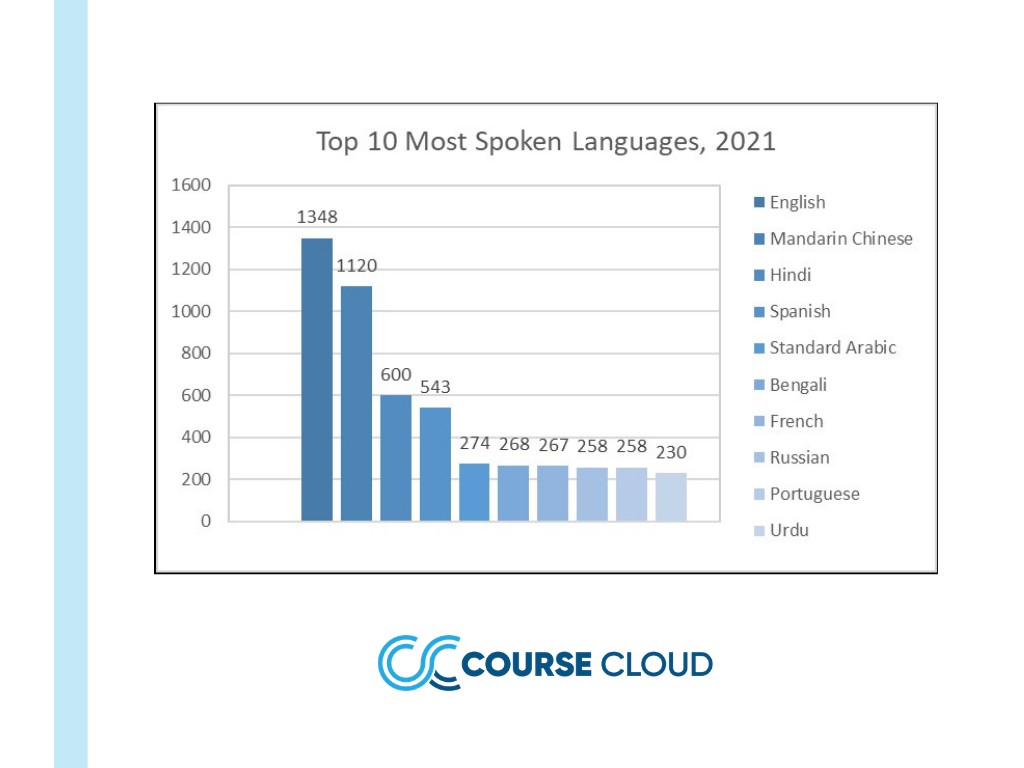How Long Does It Take To Learn Basic Spanish? It’s a common question, and at LEARNS.EDU.VN, we understand your eagerness to communicate effectively in Spanish. With dedication and the right resources, achieving basic fluency is within reach faster than you think. Learning Spanish empowers you with new career opportunities, enriches travel experiences, and enhances cognitive abilities.
1. Is Spanish Worth Learning?
Absolutely! Learning Spanish unlocks a world of opportunities. With nearly 500 million native speakers, Spanish is a global language, ranking as the world’s second-most spoken native language after Mandarin Chinese. Overall, it’s the fourth-most spoken language globally, following English, Mandarin Chinese, and Hindi.
Source: Ethnologue
Beyond statistics, Spanish offers tangible benefits:
- Enhanced Career Prospects: Bilingualism is a valuable asset in today’s global market.
- Travel Made Easier: Explore Spanish-speaking countries without language barriers.
- Improved Cognitive Function: Studies show bilingualism enhances focus and keeps your brain sharp.
- Expanded Entertainment Options: Immerse yourself in Spanish-language films, music, and literature.
- Cultural Enrichment: Discover the rich Hispanic culture and its traditions.
- Social Connections: Build friendships with people from diverse backgrounds.
2. How Easy Is Spanish To Learn?
For English speakers, Spanish is considered one of the easier languages to acquire. Its phonetic nature, where words are generally pronounced as they are written, simplifies pronunciation. Moreover, many Spanish words share Latin roots with English, making vocabulary acquisition smoother.
For example:
- Correcto means “correct.”
- Delicioso translates to “delicious.”
- Pizza is, well, “pizza.”
While mastering fluency requires dedication, the initial stages of learning Spanish are surprisingly accessible. Don’t be discouraged; LEARNS.EDU.VN offers resources to guide you every step of the way.
3. Key Considerations Before Starting Spanish
Your background and approach to learning influence your progress. Consider these factors before diving in:
- Native Language: If your native language shares similarities with Spanish (e.g., another Romance language), you may find it easier to learn.
- Age: While learning a language is possible at any age, younger learners often have an advantage in pronunciation.
- Learning Style: Identify your preferred learning style (visual, auditory, kinesthetic) to tailor your study methods.
4. Strategies For Effective Spanish Learning
To optimize your learning journey, consider these strategies:
4.1 Set Realistic And Specific Goals
Instead of aiming for vague goals like “becoming fluent,” set specific, achievable targets. For instance, aim to read a Spanish newspaper article or hold a basic conversation with a native speaker within a certain timeframe. Break down larger goals into smaller, manageable steps to stay motivated.
4.2 Remember Your Motivation
Clearly define why you want to learn Spanish. Whether it’s for travel, career advancement, or connecting with loved ones, write down your reasons and keep them visible as a reminder during challenging times.
4.3 Embrace Reading For Pleasure
Supplement textbooks with engaging reading materials like novels, magazines, and comics. Choose topics that interest you to make the learning process enjoyable and expand your vocabulary naturally.
4.4 Learn Vocabulary In Context
Instead of memorizing isolated words, learn vocabulary within phrases and sentences. This approach helps you understand how words are used in real-life situations and improves retention.
4.5 Immerse Yourself In The Language
Surround yourself with Spanish as much as possible. Listen to Spanish music, watch Spanish movies and TV shows, and try to find opportunities to speak with native speakers. Immersion accelerates language acquisition by exposing you to authentic language use.
4.6 Be Patient And Persistent
Learning a language takes time and effort. Don’t get discouraged by setbacks or slow progress. Celebrate your achievements and keep practicing consistently. Remember that even fluent speakers continue to learn and refine their skills.
5. Time Investment For Spanish Fluency
The time required to learn basic Spanish varies depending on individual factors such as learning style, motivation, and time commitment. However, here are some general guidelines:
- Basic Conversational Fluency: With consistent effort of about 1 hour per day, you can achieve basic conversational fluency within 8-12 months, equating to approximately 250-350 hours of study.
- Intensive Learning: If you dedicate more time each day, you can accelerate your progress. Some learners achieve basic fluency in as little as 6 months with a more intensive study schedule.
5.1 Mastering Spanish From Scratch
Reaching a basic conversational level in Spanish from scratch can take anywhere from 3 months to 1 year, depending on your chosen learning methods. Consistent effort and a well-structured approach are key to making progress. According to the Foreign Service Institute, languages like Spanish, which are similar to English, typically require around 24 weeks (600-750 class hours) to reach “professional working proficiency.” This translates to about six months with three hours of daily study.
Source: Foreign Service Institute
6. Factors Influencing Learning Speed
Several factors can influence how quickly you learn Spanish:
6.1 Desired Level Of Fluency
Are you aiming for conversational fluency or native-like proficiency? Conversational fluency, which allows you to understand and communicate effectively in most everyday situations, requires less time than achieving near-native fluency.
- Conversational Fluency: Understanding around 95% of spoken and written Spanish, enabling comfortable conversations at a normal pace.
- Native/Bilingual Proficiency: Understanding virtually everything, including cultural nuances, with pronunciation indistinguishable from a native speaker.
6.2 Motivation
A strong desire to learn Spanish is essential. Identify your reasons for learning and use them as fuel to stay motivated during challenging times.
6.3 Study Habits
Effective study habits, including consistent practice, focused learning sessions, and diverse learning resources, can significantly accelerate your progress. Research from the NTL Institute highlights the effectiveness of different learning methods.
6.4 Linguistic Background
If you already speak a language similar to Spanish, you may find it easier to learn due to shared vocabulary, grammar, and linguistic structures.
6.5 Immersion Opportunities
Living in a Spanish-speaking environment or having regular interactions with native speakers provides invaluable opportunities for practice and immersion, accelerating your learning.
6.6 Skill Focus
Decide which Spanish skills you want to prioritize (speaking, listening, reading, writing) and tailor your learning activities accordingly. However, a balanced approach that incorporates all four skills is generally recommended for long-term fluency.
7. The Power Of Immersion
Immersion is widely recognized as one of the fastest and most effective ways to learn Spanish. By surrounding yourself with the language and culture, you absorb new vocabulary and grammar naturally, improving fluency and comprehension.
7.1 Creating An Immersive Environment
You can create an immersive environment even without traveling to a Spanish-speaking country. Here are some tips:
- Label objects in your home with their Spanish names.
- Incorporate Spanish into your daily routines and conversations.
- Keep a journal or meditate in Spanish.
- Find a language exchange partner to practice with.
- Listen to Spanish music and podcasts.
7.2 Timeframe For Immersion Learning
With consistent immersion of three or more hours per day, you can achieve significant progress in as little as three months. Moving to a Spanish-speaking country and actively engaging with native speakers can dramatically accelerate your learning curve.
8. The Optimal Approach To Spanish Fluency
The best way to learn Spanish fluently is to practice consistently, using your listening skills and speaking Spanish as much as possible, regardless of initial imperfections.
8.1 Incorporating Spanish Music
Music is a fun and effective way to enhance your Spanish vocabulary and pronunciation. Here are some common words found in popular Spanish songs:
- Despacito = Slowly
- Mi Gente = My people
- Bailando = Dancing
- Gasolina = Gasoline
- La Bicicleta = The bicycle
- Sin Pijama = Without pyjamas
- Bella = Beautiful
- Clandestino = Clandestine or secret
- No Me Acuerdo = I don’t remember
9. Start Your Spanish Journey Today
Learning Spanish opens doors to new experiences, cultures, and opportunities. Whether you’re looking to enhance your career, travel the world, or simply expand your horizons, mastering Spanish is a rewarding endeavor.
Remember, consistency and dedication are key. With the right resources and a positive attitude, you can achieve your Spanish language goals.
Mucha suerte. Que nada te detenga. (Good luck. Do not let anything stop you.)
Ready to begin? LEARNS.EDU.VN offers a wealth of resources, from beginner courses to advanced language training. Explore our website today and discover the path to Spanish fluency that’s right for you.
FAQ: Learning Basic Spanish
1. Is Spanish hard to learn for English speakers?
Spanish is considered relatively easy for English speakers to learn due to similarities in vocabulary and grammar structure. Its phonetic nature also makes pronunciation straightforward.
2. How many hours a day should I study Spanish?
Studying Spanish for at least one hour a day can lead to basic conversational fluency within 8-12 months. More intensive study schedules can accelerate progress.
3. Can I learn Spanish in 3 months?
While achieving full fluency in 3 months is unlikely, you can make significant progress towards basic conversational skills with consistent effort and an immersive approach.
4. What are the best resources for learning Spanish?
There are numerous resources available, including online courses, language learning apps, textbooks, and language exchange partners. LEARNS.EDU.VN offers a variety of courses and resources to support your learning journey.
5. How can I improve my Spanish speaking skills?
Practice speaking as much as possible with native speakers or language partners. Focus on pronunciation, vocabulary, and grammar, and don’t be afraid to make mistakes.
6. What is the best way to learn Spanish grammar?
Understanding Spanish grammar is essential for fluency. Use textbooks, online resources, and grammar exercises to learn the rules and practice applying them in context.
7. How important is it to learn Spanish vocabulary?
Vocabulary is crucial for communication. Focus on learning high-frequency words and phrases, and use flashcards or other memorization techniques to expand your vocabulary.
8. How can I stay motivated while learning Spanish?
Set realistic goals, track your progress, reward yourself for achievements, and find ways to make learning fun and engaging. Join a language learning community for support and encouragement.
9. Is it necessary to travel to a Spanish-speaking country to learn Spanish?
While immersion can accelerate learning, it’s not essential. You can create an immersive environment at home by surrounding yourself with Spanish language and culture.
10. What should I do if I get stuck or discouraged while learning Spanish?
Don’t give up! Seek help from a tutor, language partner, or online community. Review the basics, set new goals, and remember why you started learning in the first place.
LEARNS.EDU.VN is your partner in achieving your Spanish language goals. Visit our website today to explore our comprehensive resources and unlock your potential.
Address: 123 Education Way, Learnville, CA 90210, United States
Whatsapp: +1 555-555-1212
Website: learns.edu.vn

